
views
- A 12-string guitar is easier to tune if you think about it like a guitar with 6 pairs of strings. Each pair works together to create a rich, shimmering sound.
- Use a chromatic tuner or a guitar tuning app to adjust the pitch of the strings. For standard tuning, tune the strings to eE aA dD gG BB EE, lowest to highest.
- Try tuning your guitar down a half step to reduce tension on the strings and play older 12-string songs. You can also tune your guitar to Drop-D or any open tuning.
Tuning Basics
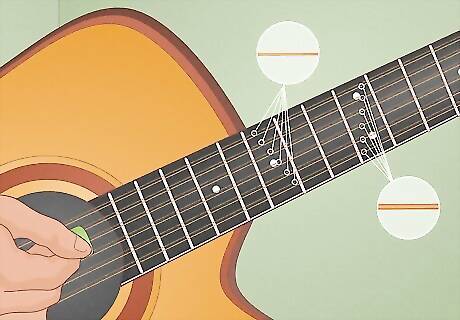
Get familiar with the guitar’s layout. On a 12-string guitar, there are 6 larger strings paired with 6 thinner strings. Strum your guitar, hitting each of the strings. Notice that instead of 12 individual notes, you’ll only hear 6 notes. The four lower, thicker strings are paired with thinner strings. These thinner strings are the same note as their pair but are tuned an octave higher. Notice that the two higher, thinner strings are paired with strings of the same thickness. These two pairs are tuned to the exact same note and the same octave. You can also put 6 strings on a 12-string guitar and play it like a normal guitar. If you have larger hands, this may give you more room to play because of the wider fretboard.
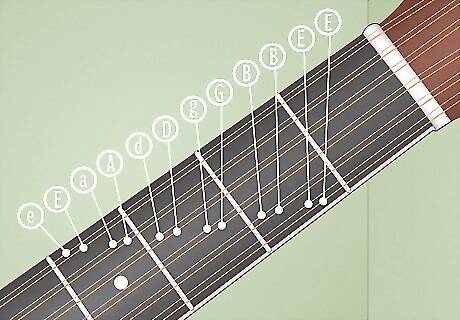
Identify the correct notes for each string. Starting with the lowest, thickest string on the guitar, the standard tuning sequence for a 6-string guitar is EADGBE. The thickest string is the same note as the thinnest string, just an octave lower. On a 12-string guitar, the standard tuning sequence is eE aA dD gG BB EE. The first letter represents the thicker strings, while the second represents their thinner partners. You can make up any acronym you’d like to remember the notes for standard tuning. Here are some of the most common ones: Eat All Day Get Big Easy, Eddie Ate Dynamite Good Bye Eddie, and Every Amateur Does Get Better Eventually.

Find the tuning pegs for each string. Each string is tuned by one peg on the headstock of the guitar. Follow each string up to its corresponding peg to see which one to turn while tuning. Play one of the thicker strings while turning the peg in each direction to figure out which way tunes the string up and which way tunes it down. When playing a 12-string guitar, remember that each pair of strings works together to create a rich shimmering sound. The only real difference between a 12-string and a 6-string guitar is that you’ll be pressing and picking two strings instead of just one.
Tuning to Standard
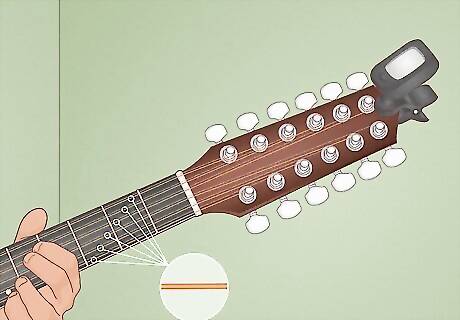
Start by correcting the pitch of the six larger strings. Turn your tuner on. Rest your hand on the strings you aren’t tuning to make sure that the tuner doesn’t pick up vibrations from the other strings. Starting with the thickest E string, pick each of the 6 larger strings individually – the tuner should tell you what the current note is. Then, twist the tuning peg while picking a string to see how far you are from the correct note, and adjust accordingly. Using a clip-on chromatic tuner is ideal because it can detect any pitch along the chromatic scale, which includes sharp notes and flat notes. Many chromatic tuners will show on a digital display whether you need to tune up or down to reach the note you need. You can also use an online tuner or a free tuning app, such as Guitar Tuna, Simply Tune, BOSS Tuner, or Fender Guitar Tuner. Make sure that the app has a chromatic or 12-string guitar setting so you can set your guitar to the right pitch. You can also tune your guitar without a tuner by ear or by tuning it to another instrument (a piano, another guitar, etc.). However, it’s often recommended to use a tuner to confirm that you’re tuning the octaves correctly.
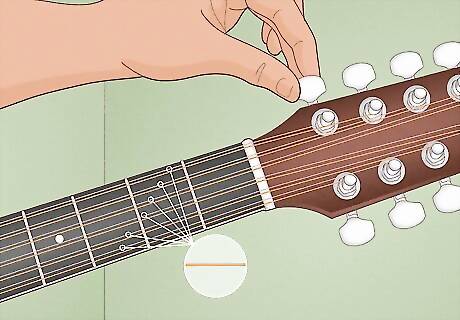
Tune the thinner paired strings once the larger 6 strings are tuned correctly. Remember that the lower four strings need to be an octave higher than their pairs. First, twist the pegs until the strings are the same note as the paired strings. Then continue to twist the pegs until the strings are exactly one octave higher. This is the easiest way to tune your paired strings. Once you’re comfortable tuning each string correctly, you can tune your strings in pairs instead of starting with the 6 thicker strings.
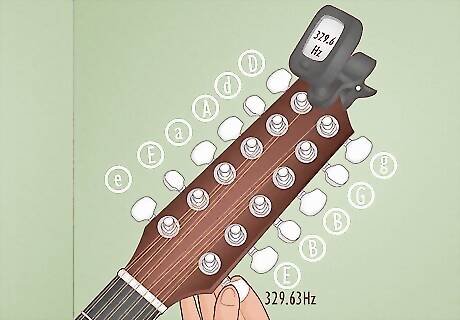
Adjust your strings to the right tuning frequency. You can also twist your pegs until you reach the right frequency, which can be seen on your chromatic tuner or on some guitar tuning apps. For more accurate tuning, here are the exact frequencies for each of the guitar’s 12 strings: e: 164.81 Hz E: 82.41 Hz a: 220.00 Hz A: 110.00 Hz d: 293.66 Hz D: 146.83 Hz g: 392.00 Hz G: 196.00 Hz B (both strings): 246.94 Hz E (both strings): 329.63 Hz
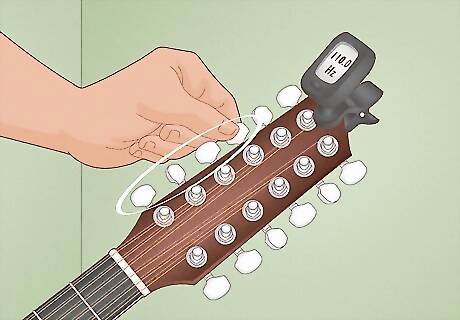
Repeat the tuning process for the first four strings. As you increase and decrease the tightness of the other strings using the tuning pegs, it could knock the first few strings out of tune, so it’s important to readjust them after you’ve completed your tuning. Most guitars don’t have a problem keeping in tune. However, 12-string guitars have a lot of neck tension, which can more easily knock your strings out of tune.
Alternative Tunings
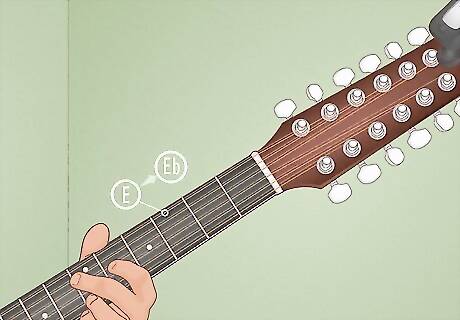
Tune Half a Step Down First, tune your guitar to standard tuning. Then, tune every string a half-step down – E becomes E flat (Eb), A becomes A flat (Ab), and so on. The complete tuning sequence will look like this: ebEb abAb dbDb gbGb BbBb EbEb. It used to be common to tune down a 12-string guitar half a step down to reduce tension on the neck. Newer guitars are designed to withstand the tension of having 12 strings, so tuning down is not usually necessary today. However, many songs will still require you to tune down. One of the benefits of tuning your guitar a step down is that you can still play any song written in standard tuning if you have a capo. A capo is used by a lot of musicians to play in different keys while using the same chord shapes they’re used to. Just place the capo on the first fret to put your guitar in standard tuning. A 12-string guitar can be more difficult for beginners to play than a 6-string because of the pressure required to press down the strings. Tuning your guitar down a half step can reduce the pressure of the strings, making it easier to play.
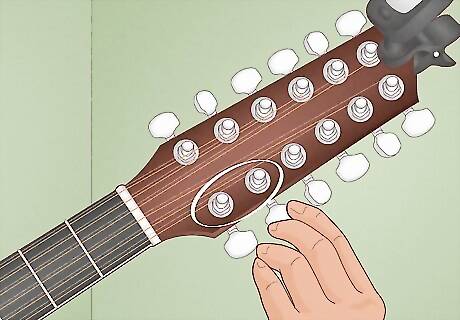
Drop-D Tuning You can tune your guitar to Drop-D to play songs that were written for Drop-D guitars. First, tune your guitar to standard tuning. Then, tune the lowest, thickest pair of E strings a whole step down to D. The tuning sequence will look like this: dD aA dD gG BB EE. Only the lowest pair of strings change from standard tuning. The larger string is still an octave apart from the thinner string, but now they’re both tuned to the D note instead of E.

Open Tuning You can tune your guitar to any open tuning you want, allowing you to play hundreds of different songs. Here are some common open-tuning sequences on 12-string guitars: Open E: eE bB eE g#G# BB EE Open D: dD aA dD f#F# AA DD Open C: eE cC gG cC GG CC Open G: dD bB gG dD GG DD DADGAD: dD aA dD gG AA DD
















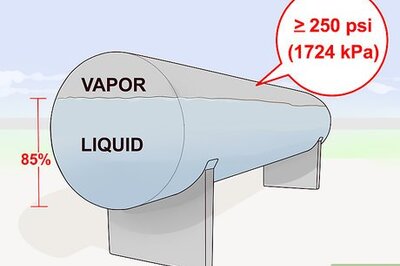



Comments
0 comment